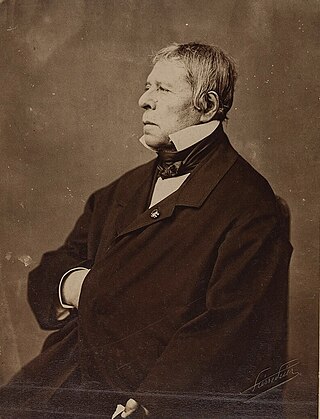
Jean-Auguste-Dominique Ingres was a French Neoclassical painter. Ingres was profoundly influenced by past artistic traditions and aspired to become the guardian of academic orthodoxy against the ascendant Romantic style. Although he considered himself a painter of history in the tradition of Nicolas Poussin and Jacques-Louis David, it is his portraits, both painted and drawn, that are recognized as his greatest legacy. His expressive distortions of form and space made him an important precursor of modern art, influencing Henri Matisse, Pablo Picasso, and other modernists.
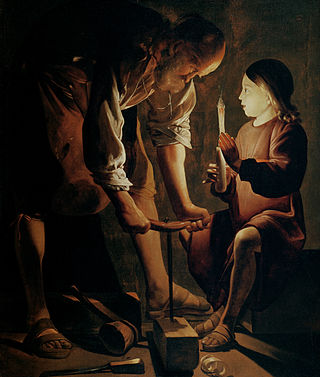
Georges de La Tour was a French Baroque painter, who spent most of his working life in the Duchy of Lorraine, which was temporarily absorbed into France between 1641 and 1648. He painted mostly religious chiaroscuro scenes lit by candlelight.

The Adoration of the Shepherds is the traditional name for a New Testament episode in the story of Jesus's nativity, which is the subject of many works of art. In it shepherds are near witnesses to Jesus's birth in Bethlehem, arriving soon after he is actually born. The episode is recounted, or at least implied, in the Gospel of Luke and follows on from the annunciation to the shepherds, in which the shepherds are summoned by an angel to the scene of the birth. Like the episode preceding it, the adoration is a common subject in art, where it is often combined with the Adoration of the Magi. In such cases it is typically just referred to by the latter title.

Bartolo di Fredi, also called Bartolo Battiloro, was an Italian painter, born in Siena, classified as a member of the Sienese School.

The Adoration of the Shepherds, sometimes still known as the Allendale Nativity, after a former owner, is a painting by the Italian Renaissance painter Giorgione, completed in about 1505 to 1510. The attribution is now usual, although not universal; the usual other view is that it is an early Titian. It is certainly a Venetian painting of that period. It is displayed in the National Gallery of Art of Washington, D.C., United States.

The Nativity of Jesus has been a major subject of Christian art since the 4th century.
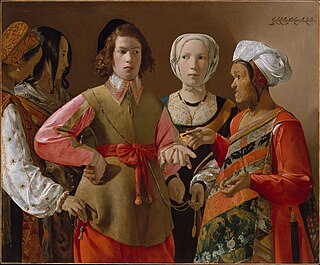
The Fortune Teller is an oil painting of circa 1630 by the French artist Georges de La Tour. The work was uncovered in about 1960 and purchased that year by the Metropolitan Museum of Art in New York.

Joseph the Carpenter is an oil painting by Georges de La Tour created circa 1642. The painting depicts a young Jesus with Saint Joseph, his earthly father.
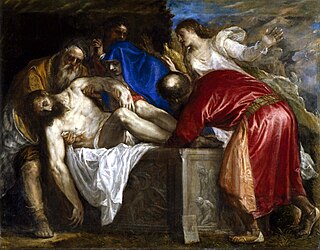
The Entombment is a 1559 oil-on-canvas painting by the Venetian painter Titian, commissioned by Philip II of Spain. It depicts the burial of Jesus in a stone sarcophagus, which is decorated with depictions of Cain and Abel and the binding of Isaac. The painting measures 137 cm × 175 cm and is now in the Museo del Prado in Madrid. Titian made several other paintings depicting the same subject, including a similar version of 1572 given as a gift to Antonio Pérez and now also in the Prado, and an earlier version of c.1520 made for the Duke of Mantua and now in the Louvre.

Magdalene with the Smoking Flame is a c. 1640 oil-on-canvas depiction of Mary Magdalene by French Baroque painter Georges de La Tour. Two versions of this painting exist, one in the Los Angeles County Museum of Art and the other in the Louvre Museum.

Saint Sebastian Tended by Saint Irene is a c.1649 oil-on-canvas painting by Georges de La Tour. It is one of the largest known paintings by the artist and his most ambitious composition. It was rediscovered in 1945 in the parish church of Bois-Anzeray and acquired by the Société des amis du Louvre for the Louvre in 1979 as inventory number R.F. 1979–53.
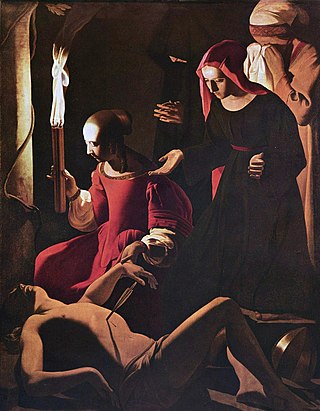
Saint Sebastian Tended by Saint Irene is a c. 1634–1643 oil-on-canvas painting of Saint Sebastian having his wounds tended by Saint Irene, which suddenly became a popular subject in the 1620s. It is now in the Gemäldegalerie, Berlin.

The Newborn Child is an oil-on-canvas painting created c. 1645–1648 by the French painter Georges de La Tour, now in the Museum of Fine Arts of Rennes in France. It is sometimes thought to be a representation of the Madonna and Child in the form of a genre scene – it is thus also known as The Nativity.

The Hurdy-Gurdy Player with a Dog is an oil-on-canvas painting executed c. 1622 by the French artist Georges de La Tour, now in the Musée du Mont-de-Piété de Bergues. It belongs to his early period and forms part of a set of works on the same subject, which also includes The Hurdy-Gurdy Player. He is also featured in The Musicians' Brawl.

Magdalene with Two Flames or The Penitent Magdalene is an undated oil-on-canvas painting created c.1640 by the French painter Georges de La Tour. In 1978 Mr. and Mrs. Charles Wrightsman gave it to the Metropolitan Museum of Art in New York, where it still hangs.
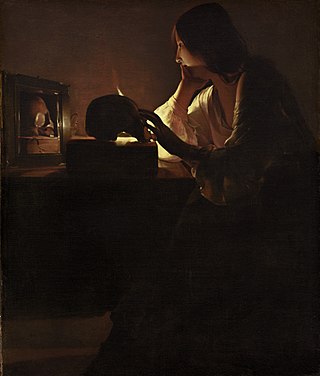
Magdalene at a Mirror or The Repentant Magdalene is a c.1635-1640 oil-on-canvas painting by the French artist Georges de La Tour. It passed from the Marquise de Caulaincourt to the Comtesse d'Andigné in 1911, before being bought in 1936 by André Fabius – it is sometimes known as The Fabius Magdalene as a result. It was then unattributed but Louvre experts attributed it to de la Tour in 1937. Fabius could not find a buyer in France and so in 1964 sold it to the National Gallery of Art in Washington, where it still hangs, though this caused a legal case since Fabius had not sought an export licence to remove the work from France.
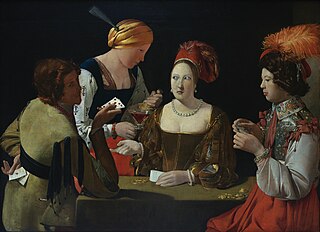
The Card Sharp with the Ace of Diamonds is an oil-on-canvas painting produced c. 1636–1638 by the French artist Georges de La Tour. It is now in the Louvre, which bought it in 1972. Though its commissioner is unknown, it is signed Georgius De La Tour fecit under the card sharp's elbow and in the shadow of the tablecloth.
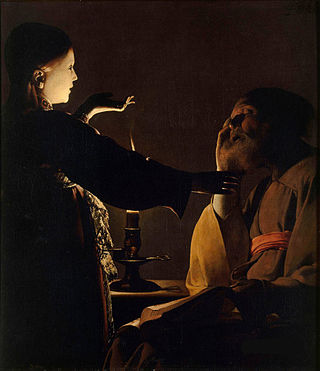
The Dream of Saint Joseph is an oil-on-canvas painting created between 1628 and 1645 by the French Baroque painter Georges de La Tour which is now in the collection of the Musée d'Arts de Nantes.


















